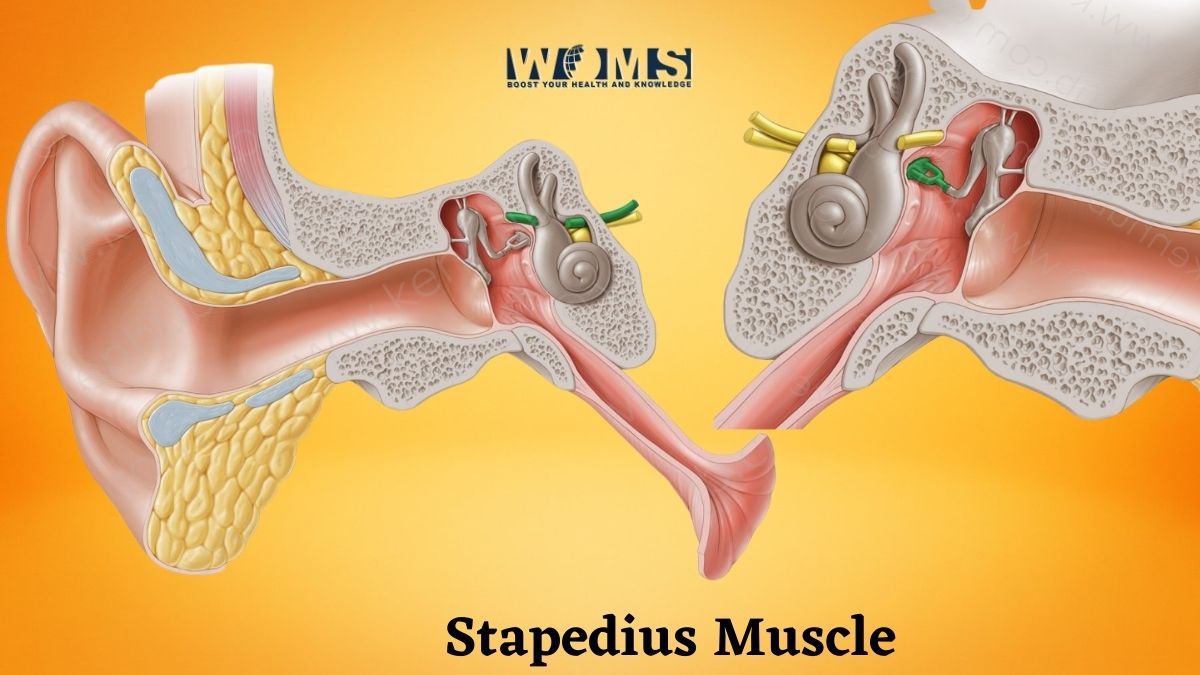The Smallest Muscle in the Body: Stapedius Muscle

In this article, Stapedius Muscle: The Smallest Muscle in the Body, you will learn all about the smallest muscle. However, the Stapedius is found in your middle ear. The stapedius, which measures less than 1mm, controls the vibration of the body’s tiniest bone structure, the stapes, commonly called the stirrup bone. it is a bone in the inner ear that serves to protect it from loud noises.
The stapedius is the smallest muscle in mammals, measuring around 6 millimeters in length. It travels from the petrous part of the temporal bone’s pyramidal eminence to the stapes neck’s posterior face in the middle ear’s tympanic chamber. The stapedius muscle is powered by the facial nerve’s stapedial branch.
The muscle can participate in the auditory middle ear reflex, which protects the auditory system, thanks to these autonomic fibers. In this essay, we looked at the function and anatomy of the smallest muscle.
What Is The Smallest Muscle?
The stapedius, the smallest muscle in the human body, is crucial in otology. The stapedius, on the other hand, is an intratympanic muscle that controls sound. The beginnings of the stapedius muscle are the fasciculi of the posterior belly of the digastric muscle, which is inserted in the mastoid groove, then passes through the stylomastoid foramen and approaches the neck of the stapes to form the stapedius, which gives fiber to the tympanic cavity.
As a result, the stapedius reflex is vital for noise protection, as well as increasing speech perception in the face of background noise. Hyperacusis is a condition in which the stapedius muscle is paralyzed, causing patients to hear normal sounds unusually loudly.
Location of the Smallest Muscle
The stapedius is the smallest muscle in the middle ear that attaches to the posterior side of the stapes’ neck and dampens vibrations transmitted to the cochlea through the oval window when flexed. From the depression of the pyramidal process, the muscle arises anteriorly into the mesotympanum, attached within the petrous temporal bone. A minor branch of the facial nerve provides it with nourishment.
The ossicular chain stiffens because of the contraction of the stapedius in reaction to sound. The resistance of the ossicular chain to sound transmission can determine the stiffness to increase.
Anatomy of the Stapedius Muscle
The smallest muscle, Stapedius, is named after the pyramidal eminence, which is a tiny elevation of the temporal bone in the tympanic cavity. It enters the neck of stapes after a rather brief journey through the tympanic cavity.
However, the facial nerve (CN VII), also called the smallest muscle nerve, and innervates the stapedius through a tiny extension that develops from it. The facial nerve innervates the stapedius muscle after branching off from the mastoid segment.
The posterior auricular artery’s stapedial branch, which branches off the external carotid artery, provides vascularization.
Tips on How to Care For the Ear and Stapedius
Taking care of your ear also entails safeguarding the smallest muscle in your body. Once you’ve lost your hearing, it’s gone forever. That’s why we educate people on the prevalence of hearing loss, the necessity of early detection, and the steps you can take to find the best hearing solution for you. Don’t put off getting your ears checked until it’s too late! Here are some simple strategies to safeguard your hearing and protect the stapedius musle.
- If you listen to music through headphones or earbuds, the 60/60 rule might help you protect your hearing. The recommendation is to listen to music with headphones at a volume of only 60% for no more than 60 minutes each day.
- Your ears require time to recover after being exposed to loud noises for an extended length of time, such as at a concert or a bar. If possible, take a five-minute break outside now and then to allow them to rest.
- Bacteria can enter and attack the ear canal if there is too much moisture. This can lead to swimmer’s ear or other types of ear infections, which can impair your hearing. After showering or swimming, make sure to carefully towel-dry your ears. If you feel water in your ear, bend your head to the side and gently tug on the earlobe to get it out.
- Clubs, concerts, lawnmowers, chainsaws, and any other noises that cause you to shout so that the person next to you can hear you all produce unsafe levels of sound. Earplugs are simple to get and use. Your local hearing healthcare professional can even custom fit a pair for you.
- It’s usual for people to wipe wax out of their ear canals with cotton swabs, but this is not recommended. A small amount of wax in your ears is not only normal but also beneficial. Wax prevents dust and other hazardous particles from entering the canal because the ears are self-cleaning organs.
Summary of the Smallest Muscle
There are arguably 3 kinds of muscles in the human body, each of which comprises hundreds of them. Muscles assist the body in moving and functioning effectively. Your body is a complex biological machine with amazing capabilities. Looking at some of our varied components and asking questions like “where is the smallest muscle located?” can help us understand how our bodies work and, ultimately, how to keep them healthy.
FAQs
What is the function of the smallest muscle in the body?
The stapedius, which is less than 1 mm long, is responsible for controlling the vibration of the body’s tiniest bone, the stapes, or stirrup bone. The stapedius, on the other hand, is a bony structure that shields the inner ear from loud noises.
Which muscle in the human body is the most powerful?
The masseter is the most powerful muscle based on its size. It can close the teeth with a force of up to 55 pounds (25 kilograms) on the incisors and 200 pounds (90.7 kilograms) on the molars when all the jaw muscles are acting simultaneously.
What is the body’s most essential muscle?
The human heart is the most amazing muscle in the body, pumping 100,000 times every day to transport 3,600 gallons of blood across 75,000 miles of blood channels.
What is the length of the stapedius muscle?
The stapedius is the body’s smallest muscle, measuring only 1 mm. It develops from the pyramidal eminence, a protrusion in the tympanic cavity’s posterior aspect.
What is the location of the Stapedius muscle?
The stapedius muscle is a small middle ear muscle that attaches to the posterior side of the stapes’ neck and dampens vibrations transmitted to the cochlea through the oval window when flexed.




